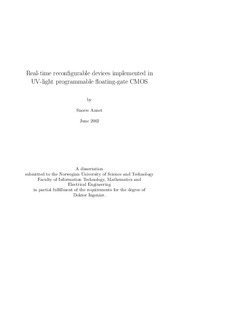| dc.contributor.author | Aunet, Snorre | nb_NO |
| dc.date.accessioned | 2014-12-19T11:25:10Z | |
| dc.date.available | 2014-12-19T11:25:10Z | |
| dc.date.created | 2002-07-30 | nb_NO |
| dc.date.issued | 2002 | nb_NO |
| dc.identifier | 126318 | nb_NO |
| dc.identifier.isbn | 82-471-5447-1 | nb_NO |
| dc.identifier.uri | http://hdl.handle.net/11250/231330 | |
| dc.description.abstract | This dissertation describes using theory, computer simulations and laboratory measurements a new class of real time reconfigurable UV-programmable floating-gate circuits operating with current levels typically in the pA to μA range, implemented in a standard double-poly CMOS technology. A new design method based on using the same basic two-MOSFET circuits extensively is proposed, meant for improving the opportunities to make larger FGUVMOS circuitry than previously reported. By using the same basic circuitry extensively, instead of different circuitry for basic digital functions, the goal is to ease UV-programming and test and save circuitry on chip and I/O-pads. Matching of circuitry should also be improved by using this approach.
Compact circuitry can be made, reducing wiring and active components. Compared to earlier FGUVMOS approaches the number of transistors for implementing the CARRY’ of a FULL-ADDER is reduced from 22 to 2. A complete FULL-ADDER can be implemented using only 8 transistors. 2- MOSFET circuits able to implement CARRY’, NOR, NAND and INVERT functions are demonstrated by measurements on chip, working with power supply voltages ranging from 800 mV down to 93 mV. An 8-transistor FULL-ADDER might use 2500 times less energy than a FULL ADDER implemented using standard cells in the same 0.6 μm CMOS technology while running at 1 MHz. The circuits are also shown to be a new class of linear threshold elements, which is the basic building blocks of neural networks. Theory is developed as a help in the design of floating gate circuits. | nb_NO |
| dc.language | eng | nb_NO |
| dc.publisher | Fakultet for informasjonsteknologi, matematikk og elektroteknikk | nb_NO |
| dc.relation.ispartofseries | Dr. ingeniøravhandling, 0809-103X; 2002:52 | nb_NO |
| dc.relation.haspart | Aunet, Snorre; Berg, Yngvar; Sæther, Trond. Floating-gate low-voltage/low-power linear threshold element for neural computation. IEEE International Symposium on Circuit and Systems. 2: 528-532, 2002. | nb_NO |
| dc.relation.haspart | Aunet, Snorre; Berg, Yngvar; Næss, Øyvind; Sæther, Trond. Novel reconfigurable two-MOSFET UV-programmable floating-gate circuits for CARRY, NAND, NOR or INVERT functions. IEEE International Conference on Electronics, Circuits and Systems. 2: 528-531, 2001. | nb_NO |
| dc.relation.haspart | Aunet, Snorre; Berg, Yngvar; Tjore, Odd; Næss, Øyvind; Sæther, Trond. Four-MOSFET Floating-Gate UV-Programmable Elements for Multifunction Binary Logic. Proceedings of the 2001 World Multiconference on Systemics, Cybernetics and Informatics: 141-144, 2001. | nb_NO |
| dc.relation.haspart | Aunet, Snorre; Berg, Yngvar; Sæther, Trond. A New 2-MOSFET Universal Floating-Gate Element for Reconfigurable Digital Logic. . | nb_NO |
| dc.relation.haspart | Aunet, Snorre; Berg, Yngvar; Næss, Øyvind; Sæther, Trond. A New Universal UV-Programmable Floating-Gate Digital Element With Application to an 8-Transistor Full-Adder and a D-Latch. . | nb_NO |
| dc.title | Real-time reconfigurable devices implemented in UV-light programmable floating-gate CMOS | nb_NO |
| dc.type | Doctoral thesis | nb_NO |
| dc.contributor.department | Norges teknisk-naturvitenskapelige universitet, Fakultet for ingeniørvitenskap og teknologi | nb_NO |
| dc.description.degree | dr.ing. | nb_NO |
| dc.description.degree | dr.ing. | en_GB |
